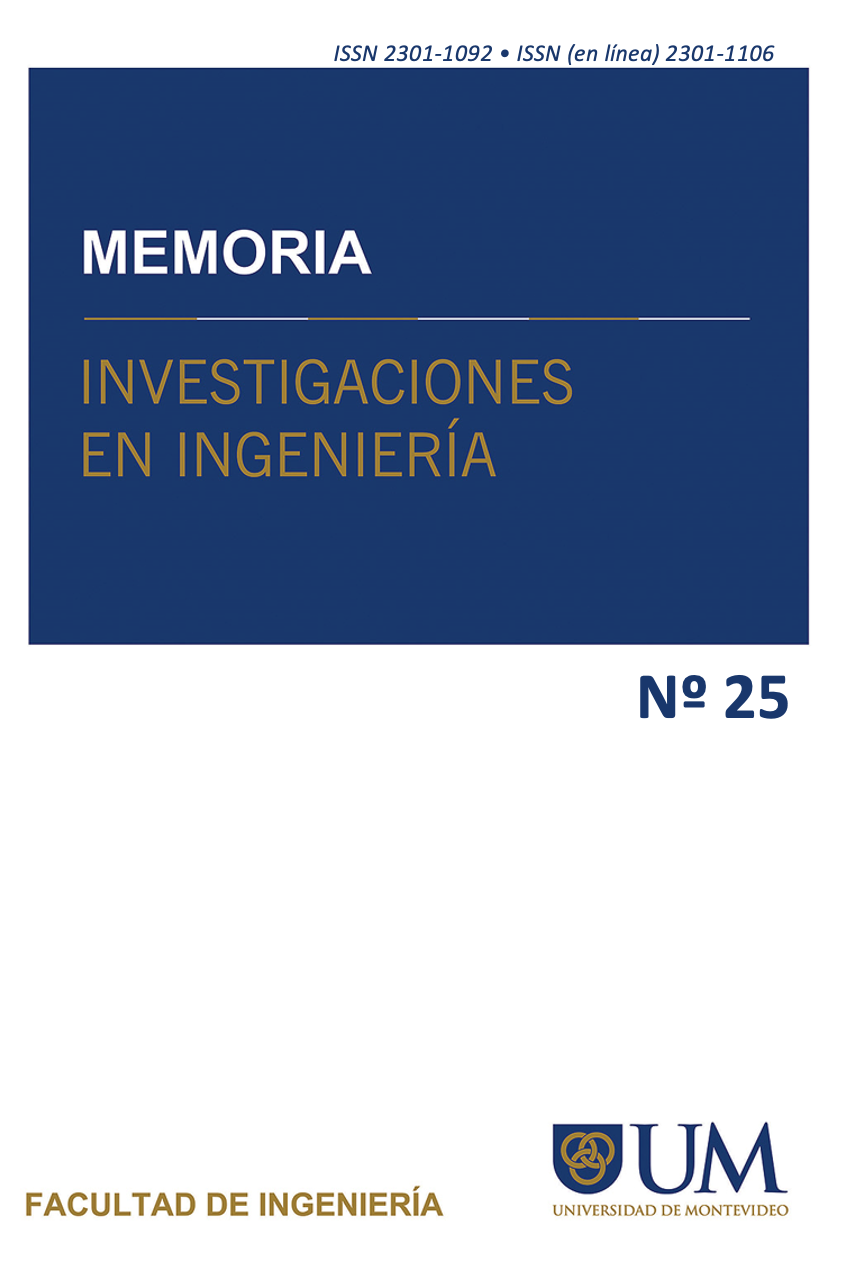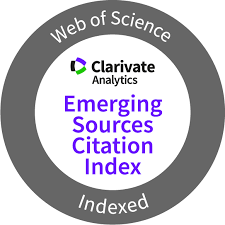Indoor carbon dioxide and COVID-19
assessment of air quality and its relationship with ventilation, temperature and humidity
DOI:
https://doi.org/10.36561/ING.25.2Keywords:
Carbon dioxide, Ventilation, Temperature, RH, Prevention, COVID-19Abstract
Indoor air quality is a crucial factor for people's health and well-being, since 90% of many people spend time indoors. The objective of this research was to verify the correlation of carbon dioxide with various study variables. To obtain the concentrations, a direct reading measuring equipment was used and monitoring was carried out for two months (September and October 2021). The Kolmogorov-Smirnov test was applied because the data did not follow a normal distribution, and Spearman's correlation was used, the results indicated a (Rho= -0.584; Sig. (bilateral)=0.00< p=0 0.05), which shows that there is a negative moderate inverse significant correlation between CO2 and ventilation, with respect to carbon dioxide and humidity, has a Spearman coefficient (Rho= -0.180; Sig. (bilateral)=0.315< p=0.05), so there is a very weak inverse negative correlation, in the same way a Spearman coefficient is observed (Rho= 0.130; Sig. (bilateral)=0.470< p=0.05, In conclusion, it is showed a moderate negative correlation between carbon dioxide and ventilation, which means that the higher the concentration of carbon dioxide, the lower the ventilation.Therefore, it is important that windows exist in work environments to ensure adequate ventilation. and create a healthy environment that does not harm people's health and reduces the risk of contagion of COVID-19.
Downloads
References
Agarwal, N., Meena, C. S., Raj, B. P., Saini, L., Kumar, A., Gopalakrishnan, N., Kumar, A., Balam, N. B., Alam, T., Kapoor, N. R., & Aggarwal, V. (2021). Indoor air quality improvement in COVID-19 pandemic: Review. Sustainable Cities and Society, 70 (April), 102942. Disponible en: https://doi.org/10.1016/j.scs.2021.102942
Bartyzel, J., Zieba, D., Necki, J., & Zimnoch, M. (2020). Assessment of ventilation efficiency in school classrooms based on indoor-outdoor particulate matter and carbon dioxide measurements. Sustainability (Switzerland), 12(14), 1–9. https://doi.org/10.3390/su12145600
Bazant, M. Z., Kodio, O., Cohen, A. E., Khan, K., Gu, Z., & Bush, J. W. M. (2021). Monitoring carbon dioxide to quantify the risk of indoor airborne transmission of COVID-19. Flow, 1, 1–20. Disponible en: https://doi.org/10.1017/flo.2021.10
Berenguer, & Bernal. (2000). NTP 549 : El dióxido de carbono en la evaluación de la calidad del aire interior. In Instituto Nacional de Seguridad e Higiene en el Trabajo (pp. 1–9). http://www.insht.es/InshtWeb/Contenidos/Documentacion/FichasTecnicas/NTP/Ficheros/501a600/ntp_549.pdf
Constantin, J. G., Quici, N., Lichtig, P., & Espada, R. (2020). Transmisión de SARS - CoV - 2 por vía aérea ( inhalación de aerosoles ). Medidas de reducción de exposición . December. Disponible en: https://doi.org/10.13140/RG.2.2.24185.90728
Departamento de salud ambiental de Madrid. (2020). Medición de la concentración de CO2 como indicador de una ventilación adecuada de edificios y locales . COVID19. Madrid Salud, Octubre, 6. Disponible en: https://madridsalud.es/wp-content/uploads/2020/11/InfSAM33-2020Ventilacion_interio_como_medida_preventivaCOVID19.pdf
Ferreira, A. M. da C., & Cardoso, M. (2014). Indoor air quality and health in schools. Jornal Brasileiro de Pneumologia, 40(3), 259–268. https://doi.org/10.1590/s1806-37132014000300009
Guijarro Miragaya, P., Estay Leal, T., Patrón Saade, L., & Tendero Caballero, R. (2021). The CO2 assessment in a school classroom for an optimal natural ventilation strategy = The CO2 assessment in a school classroom for an optimal natural ventilation strategy. Building & Management, 5(3), 29. https://doi.org/10.20868/bma.2021.3.4712
Ha, W., Zabarsky, T. F., Eckstein, E. C., Alhmidi, H., Jencson, A. L., Cadnum, J. L., & Donskey, C. J. (2022). Use of carbon dioxide measurements to assess ventilation in an acute care hospital. American Journal of Infection Control, 50(2), 229–232. https://doi.org/10.1016/j.ajic.2021.11.017
Hernández. (2010). Metdologia de la Investigación (McGRAW-HILL (ed.); Sexta Edic). https://scholar.google.es/scholar?hl=es&as_sdt=0%2C5&q=metodologia+de+la+investigacion++sampieri&btnG=
Jiménez. (2021). Guía De Referencia Covid:Control de Contagio de COVID 19 en espacios interiores compartidos (p. 36). Disponible en: http://www.zaragoza.es/contenidos/coronavirus/guia-referencia-covid.pdf
Laurent, M. R., & Frans, J. (2022). Monitors to improve indoor air carbon dioxide concentrations in the hospital: A randomized crossover trial. Science of the Total Environment, 806. Disponible en: https://doi.org/10.1016/j.scitotenv.2021.151349
Mfarrej, F., Qafisheh, N., & Bahloul, M. (2020). Investigation of Indoor Air Quality inside Houses From UAE. Air, Soil and Water Research, 13, 5–8. Disponible en: https://doi.org/10.1177/1178622120928912
Ministerio de Salud. (2021). Disposiciones para la vigilancia,prevención y controlde la salud de los trabajadores con riesgo de exposición a SARS COV2 (Directiva Administrativa N° 321-MINSA/DGIESP-2021; p. 38). Disponible en: https://www.gob.pe/institucion/minsa/normas-legales/2513071-1275-2021-minsa
Ministerio de Trabajo y Promoción del Empleo. (2020). Notificaciones de accidentes de trabajo, incidentes peligrosos y enfermedades ocupacionales. In Boletín Notificaciones enero 2021. Disponible en: https://elcomercio.pe/economia/peru/peru-segundo-pais-mayor-incidencia-muertes-laborales-latinoamerica-436169
Lazovic, I., Stevanovic, Z., Jovasevic-Stojanovic, M., Zivkovic, M., & Banjac, M. (2016). Impact of CO2 concentration on indoor air quality and correlation with relative humidity and indoor air temperature in school buildings in Serbia. Thermal Science, 20(suppl. 1), 297–307. Disponible en: https://doi.org/10.2298/tsci150831173l
Ley 29783 de Seguridad y Salud en el Trabajo.pdf, 13 (2011). Disponible en: https://www.sunafil.gob.pe/seguridad-y-salud-en-el-trabajo.html#i-marco-legal-2
Li, H., Fan, H., & Mao, F. (2016). A visualization approach to air pollution data exploration-A case study of air quality index (PM2.5) in Beijing, China. Atmosphere, 7(3). Disponible en: https://doi.org/10.3390/atmos7030035
Morales, I. M., Acevedo., V. B., & Nieto, A. G. (2021). Calidad del aire interior (BOCM (ed.); Primera, d). Enciclopedia de salud y seguridad en el trabajo. Disponible en: http://ladep.es/ficheros/documentos/44.pdf
Organización Mundia de la Salud. (2017). Entornos laborales saludables Interrelaciones entre Trabajo, Salud y Comunidad. Entornos Laborales Saludables: Fundamentos y Modelo de La OMS :Contextualización, Prácticas y Literatura de Apoyo., 1–121. Disponible en: http://www.who.int/occupational_health/evelyn_hwp_spanish.pdf
Peralta. (2020). Las enfermedades profesionales como uno de los riesgos dentro de la seguridad y salud del trabajo. Revista de La Abogacía, 64, 155–175. www.ojs.onbc.cu
Piia, T., Urbane, V., Traumann, A., & Jarvis, M. (2020). The prevention from infection with COVID-19 of students in auditoriums through carbon dioxide measurements–an evidence from Estonian and Latvian high schools. Safety and Health at Work, January. Disponible en: https://www.webofscience.com/wos/woscc/full-record/WOS:000760944700454
Pulimeno, M., Piscitelli, P., Colazzo, S., Colao, A., & Miani, A. (2020). Indoor air quality at school and students’ performance: Recommendations of the UNESCO Chair on Health Education and Sustainable Development & the Italian Society of Environmental Medicine (SIMA). Health Promotion Perspectives, 10(3), 169–174. https://doi.org/10.34172/hpp.2020.29
Ruiz. (2021). Sistema de evaluación y control de la renovación de aire para prevenir la transmisión del COVID-19 en aulas [Univesridad de Vigo]. Disponible en: http://calderon.cud.uvigo.es/bitstream/handle/123456789/448/RuizFontán%2CJesús-Memoria.pdf?sequence=1&isAllowed=y
Santillan Garcia, A. (2021). Cómo ventilar un espacio cerrado para evitar el contagio por coronavirus (Issue January). Disponible en: https://www.researchgate.net/publication/350633387
Serrano Jiménez, A., Lizana, J., Molina Huelva, M., & Barrios Padura, Á. (2020). Indoor environmental quality in social housing with elderly occupants in Spain: Measurement results and retrofit opportunities. Journal of Building Engineering, 30(December 2019). Disponible en: https://doi.org/10.1016/j.jobe.2020.101264
Toro. (2018). Efectos de la contaminación atmosferica. 1–27. Disponible en: https://www.solerpalau.com/es-es/blog/efectos-co2/
Vega. (2020). ¿El trabajo es salud? In Archivos de prevencion de riesgos laborales (Vol. 23, Issue 4, pp. 410–414). Disponible en: https://doi.org/10.12961/aprl.2020.23.04.01
Wang, W., Shan, X., Hussain, S. A., Wang, C., & Ji, Y. (2020). Comparison of multi-control strategies for the control of indoor air temperature and co2 with openmodelica modeling. Energies, 13(17). Disponible en: https://doi.org/10.3390/en13174425























